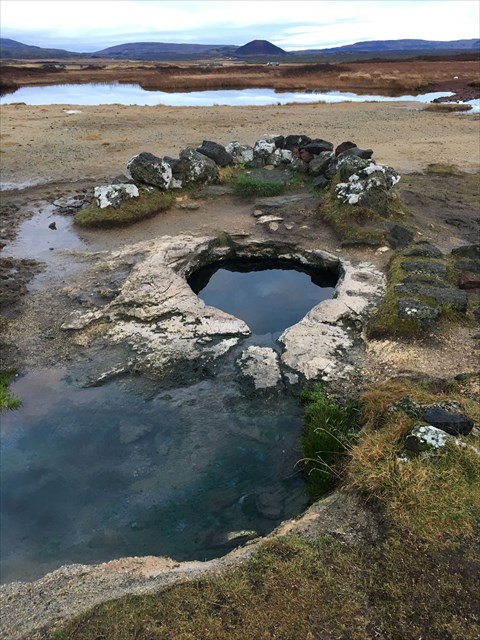Overview:
'Heit Laug' is the Icelandic translation for hot spring (or hot pot) which is an area where the water temperature of the spring is significantly higher than the air temperature of the surrounding region. Most hot springs discharge ground water that is heated by shallow intrusions of magma (molten rock) in volcanic areas like the one you're standing in!

Description:
Water issuing from a hot spring is heated geothermally, that is, with heat produced from the Earth's mantle. In general, the temperature of rocks within the earth increases with depth. The rate of temperature increase with depth is known as the geothermal gradient.
In active volcanic zones, water may be heated by coming into contact with magma (molten rock). The high temperature gradient near magma may cause water to be heated enough that it boils or becomes superheated. If the water becomes so hot that it builds steam pressure and erupts in a jet above the surface of the Earth, it is called a geyser (from the Icelandic spring, Geysir, and the word for gush). If the water only reaches the surface in the form of steam, it is called a fumarole. If the water is mixed with mud and clay, it is called a mud pot. Note that hot springs in volcanic areas are often at or near the boiling point.

Hot groundwater dissolves minerals from rock that it passes through because water becomes a more effective solvent when hot, so people use the water emitted at hot springs as relaxing mineral baths (please enjoy responsibly!) Natural pools of geothermal water may become brightly colored and the gaudy greens, blues, and oranges of these pools come from thermophyllic (heat-loving) bacteria and archaea that thrive in hot water and metabolize the sulphur containing minerals dissolved in the groundwater.
To log this Earthcache:
Please answer the following questions and then proceed with your log. Anyone who doesn't submit answers to the questions in a timely manner will have their logs deleted without notice.
- Is the water in this hot spring at or near it's boiling point? Why or why not?
- What evidence of thermophyllic bacteria do you see (if any)?
- What evidence of volcanic activity can you see from GZ? Describe.
Bonus:
- Post a picture of volcanic evidence you find in or around GZ!
References:
- https://www.britannica.com/science/hot-spring
- https://en.wikipedia.org/wiki/Hot_spring
- http://geologylearn.blogspot.com/2015/12/hot-springs-and-geysers.html
Congrats to cheburs on the FTF!